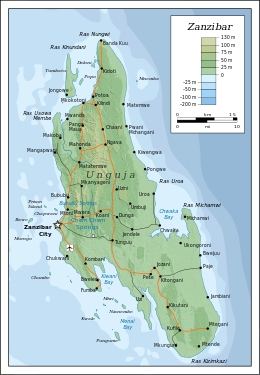Changuu

Unguja and surrounding islands
|
|
| Geography | |
|---|---|
| Location | Indian Ocean |
| Coordinates | 6°7′9.81″S 39°9′56.06″E / 6.1193917°S 39.1655722°ECoordinates: 6°7′9.81″S 39°9′56.06″E / 6.1193917°S 39.1655722°E |
| Archipelago | Zanzibar Archipelago |
| Length | 0.8 km (0.5 mi) |
| Width | 0.23 km (0.143 mi) |
| Administration | |
| Region | Zanzibar |
Changuu Island (also known as Kibandiko, Prison or Quarantine Island) is a small island 5.6 km north-west of Stone Town, Unguja, Zanzibar. The island is around 800m long and 230m wide at its broadest point. The island saw use as a prison for rebellious slaves in 1860s and also functioned as a coral mine. The British First Minister of Zanzibar, Lloyd Mathews, purchased the island in 1893 and constructed a prison complex there. No prisoners were ever housed on the island and instead it became a quarantine station for yellow fever cases. The station was only occupied for around half of the year and the rest of the time it was a popular holiday destination. More recently, the island has become a government-owned tourist resort and houses a collection of endangered Aldabra giant tortoises which were originally a gift from the British governor of the Seychelles.
Changuu is named after the Swahili name of a fish which is common in the seas around it, though it is shown as "Kibandiko Island" on some older maps, but this name is no longer used. The island was uninhabited until the 1860s when the first Sultan of Zanzibar, Majid bin Said, gave it to two Arabs who used it as a prison for rebellious slaves prior to shipping them abroad or selling them at the slave market in Zanzibar's Stone Town. Zanzibar became a British protectorate following the 1890 Heligoland-Zanzibar Treaty with Germany, this resulted in the appointment of a British First Minister, Lloyd Mathews, in October 1891. Mathews purchased Changuu from its Arab owners on behalf of the Zanzibar government in 1893 with the intention of building a prison upon it. The prison was to have housed violent and recidivist criminals from the part of the African mainland which was then under the jurisdiction of Zanzibar. Despite the prison buildings being completed in 1894, causing the island to become known commonly as "Prison Island", the facility never housed prisoners.
...
Wikipedia

